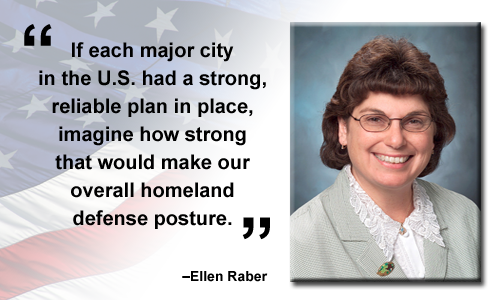Lab develops response plan for biological attack
Think fast: if you were in charge of a major U.S. city's response to a large-scale biological attack and it happened tomorrow, what would you do?
Not sure? It turns out that the task is an extremely difficult one and there currently is no plan in place. The consequences for delay are high — for example, if the San Francisco International Airport (SFO) were shut down, the cost in lost revenue alone would be $85 million per day.
Enter S Program's Interagency Biological Restoration Demonstration (IBRD) program. With funding from the Department of Homeland Security and Department of Defense, the IBRD program's wide-area biological remediation planning is an effort to strengthen the U.S. response to and recovery from a large-scale, wide-area attack involving the release of a biological agent.
The Lawrence Livermore-Sandia national laboratories IBRD team has produced a draft document that answers the "what would you do?" question for major urban areas in the U.S. "Interim Consequence Management Guidance for a Wide-Area Biological Attack" that has been delivered to the Homeland Security Council. Interagency comments are currently being addressed by the team, and the final document is due out this summer.
As one might suspect, there is an intimidating network of considerations that must be optimized immediately following such an event, most of which cannot be addressed effectively without preplanning.
Explains Ellen Raber, deputy program manager of Global Security's S Program: "Who determines what happened, the potential impact on human health and the environment, or how information is communicated to the public? Who has jurisdiction for which elements of the response? Who takes care of people versus property, decides whether to evacuate or shelter in place, or addresses economic factors without counteracting health and safety factors? Who provides equipment to deal with decontamination and analysis, and who is trained to use that equipment? As federal, state, county, local and even facility-based authority structures scramble to respond, how are resources shared, and who gets their way when the various entities cross paths?"
IBRD's remediation plan tackles hundreds of such issues, laying out a blueprint that each layer of authority can consult. The target audience for this document spans the gamut, from federal, state and local emergency responders to government officials at all levels, to those in the chain of command during response, remediation and recovery. Raber notes that the plan provides generic guidance with technical options for any given jurisdiction to create its own specific plan. The plan also can be used as operational guidance if need be.
"This plan is just the beginning," Raber says. "We're in the process of developing a follow-on plan with Seattle as the partner city. This follow-on plan will include templates and specific local-level planning guidelines. We'll put it to the test in a demonstration planned for late 2011 or early 2012."
LLNL's success in consequence-management planning has led to even more work. From the initial "Facility Biological Remediation Guidance" document for SFO, to chemical response plans for the Los Angeles International Airport, to recovery plans for subways following the explosion of a radiation dispersal device to table-top emergency exercises in San Francisco and elsewhere, S Program's experts are in high demand.
"We keep getting more work," Raber says. "If each major city in the U.S. had a strong, reliable plan in place, imagine how strong that would make our overall homeland defense posture. But for this to work right, plans have to be put in place one city at a time, and we need to have the help and buy-in from key stakeholders at all levels."
To meet this growing demand, S Program is looking for individuals with experience in environmental engineering and environmental regulations. Contact raber1 [at] llnl.gov (Ellen Raber) for more information.






